Justice Dimaampao Discusses Access to Justice in the Philippines in ASEAN Forum on Victim-Sensitive Adjudication of Trafficking Cases
July 28, 2023
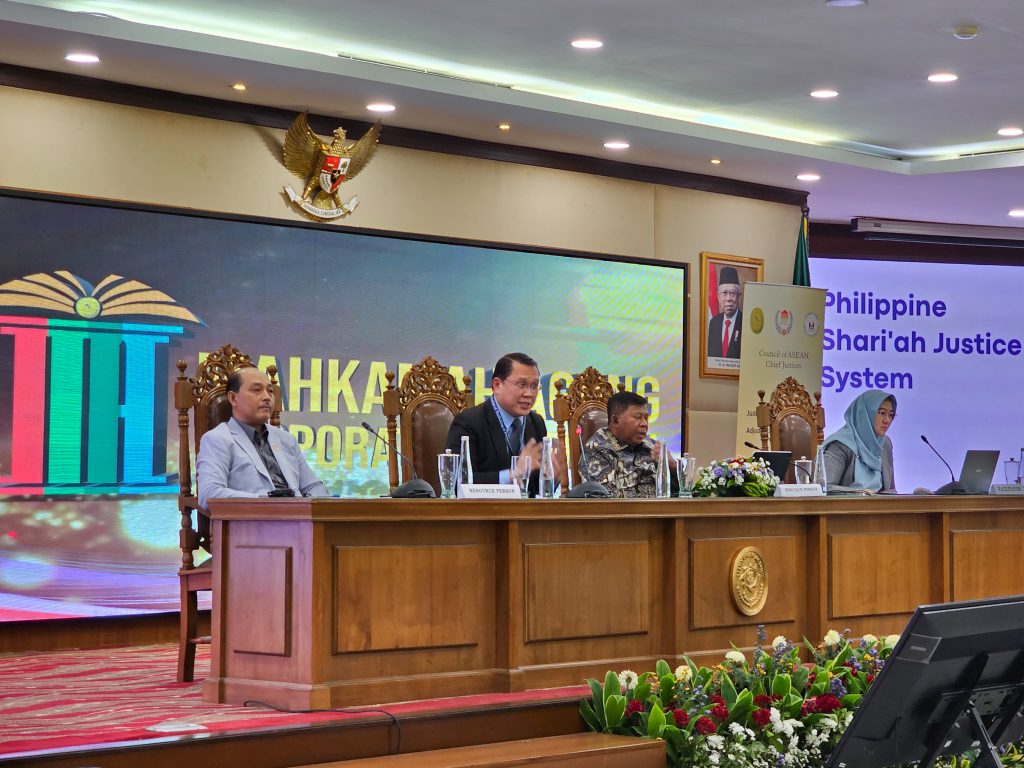
Supreme Court Associate Justice Japar B. Dimaampao (second from left) is one of the featured panelists during the roundtable discussions at the ASEAN Judicial Knowledge Exchange on Victim-Sensitive Adjudication of Trafficking in Persons (TIP) Cases held in Bogor, Indonesia on July 25, 2023. With Justice Dimaampao are (from left) Dr.(iur). Antonius PS Wibowo, S.H., M.H., Deputy Chair of Witness and Victim Protection Agency of Indonesia and Indonesian magistrates Hon. Justice Dr. Prim Haryado, S.H., M.H., Justice of Supreme Court and Judge Dr. Rosana Kusuma Hidayah, S.H., M.Si., Supreme Court Registrar.
“Access to Justice is a multifaceted issue that requires a comprehensive approach. Together, we can build a future where justice is truly accessible to all.”
Thus stressed Supreme Court Associate Justice Japar B. Dimaampao in his discussion on Access to Justice on Day 1 of the three-day ASEAN Judicial Knowledge Exchange on Victim-Sensitive Adjudication of Trafficking in Persons (TIP) Cases held at the Research and Development and Education and Training Agency for Law and Justice of the Supreme Court of Indonesia in Bogor, Indonesia on July 25, 2023.
Justice Dimaampao gave a presentation titled, “Access to Justice in the Philippines: Challenges and Practices,” focusing on: restitution and compensation; access to justice for women and children in the criminal justice system; disability inclusion in the Philippines; and the Philippine Shari’ah justice system.
Among the Philippine policies Justice Dimaampao discussed are the Anti- Violence Against Women and their Children Act; the Family Courts Act; the Rule on Examination of Child Witness; the Magna Carta for Persons with Disabilities, the Rules for the Implementation of the Filipino Sign Language Act, which is in the process of being drafted; the Code of Muslim Personal Laws of the Philippines; and the Organic Law for the Bangsamoro Autonomous Region in Muslim Mindanao (BARMM).
He also highlighted the recently concluded First National Shari’ah Summit held last March 5 and 6, 2023 in Cagayan de Oro City, which gathered over 300 court officials, Shari’ah counselors, Shari’ah judges, legal professionals, and foreign delegates. With the Summit’s goal of strengthening the Shari’ah justice system anchored on the need to assess its institutional framework, including the internal capacities within broader historical, cultural, and ideological contexts as well as within the context of the current BARMM governance framework, Justice Dimaampao remarked: “We are one step closer to ensuring that Shari’ah justice is accessible to all Muslims in the Philippine society.”
Consistent with the Strategic Plan for Judicial Innovations 2022-2027 (SPJI), the Court’s blueprint for judicial reform, Justice Dimaampao underscored the role of technological advancements and increased awareness and innovation in creating a more inclusive and effective justice system.
The ASEAN Judicial Knowledge Exchange on Victim-Sensitive Adjudication of TIP Cases held in Bogor and Jakarta, Indonesia, is a Pilot Project between the Council of ASEAN Chief Justices (CACJ) Working Group on Judicial Education and Training (WG-JET) co-chairs Indonesia and the Philippines.
In addition to Justice Dimaampao, the following Filipino magistrates also presented at the event: Court of Appeals (CA) Associate Justice Jose Lorenzo R. Dela Rosa, on the decision analysis on TIP cases in the Philippines; Judge Sita Jose Clemente, Regional Trial Court (RTC), Branch 16, Malolos, Bulacan, on practices and challenges of applying victim-sensitive court indicators in TIP cases; Judge Jocelyn Sundiang-Dilig, RTC, Branch 47, Puerto Princesa, Palawan, on child-sensitive adjudication of TIP cases; Judge Lorna Catris-Chua Cheng, RTC, Branch 168, Marikina City on the implementation of Do-No-Harm principles in TIP cases; Judge Cynthia Martinez-Florendo, RTC, Branch 39, San Jose, Nueva Ecija, on court practices on TIP case handling; and Judge Sittie Laarni Rakiin Umpa, RTC, Branch 9, Marawi City, Lanao del Sur on practices and challenges in religious courts.
Justice Dimaampao, together with Philippine Judicial Academy Chancellor Rosmari D. Carandang, the head of the Philippine delegation, and CA Associate Justice Dela Rosa, also led the Philippine delegation on a visit to Pengadilan Negeri Depok, a District Court of Depok State on Day 2 of the event on July 26, 2023.
On Day 3, Justice Dimaampao returned to the Knowledge Exchange to join the panel which discussed religious court practices. On the same day, the Justice also took part in a dialogue with Indonesian magistrates held at the Supreme Court of Indonesia in Jakarta.
Justice Dimaampao, Chancellor Carandang, and Justice Dela Rosa, were joined by Judicial Reform Program Administrator Atty. Laura C.H. Del Rosario, other Court officials and Court lawyers, and select lower court judges. (Photos courtesy of the Office of Justice Japar B. Dimaampao)
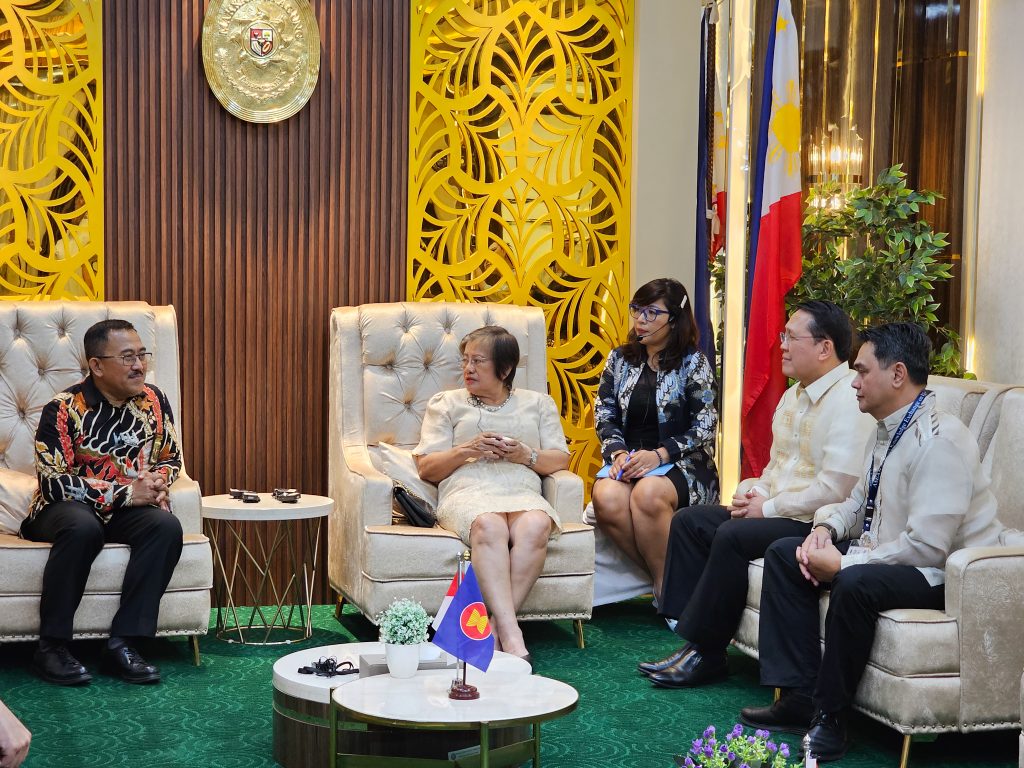
Supreme Court Associate Justice Japar B. Dimaampao (second from right), Philippine Judicial Academy (PhilJA) Chancellor and retired Supreme Court Associate Justice Rosmari D. Carandang (second from left), and Court of Appeals Associate Justice Jose Lorenzo R. dela Rosa (right) are welcomed by (left) Justice Bambang Hery Mulyono, S.H., M.H., Head of the Research and Development Agency for Legal and Judicial Training of the Supreme Court Republic of Indonesia at the ASEAN Judicial Knowledge Exchange on Victim-Sensitive Adjudication of Trafficking in Persons Cases held in Bogor, Indonesia on July 24, 2023. (Photo courtesy of the Office of Justice Japar B. Dimaampao)
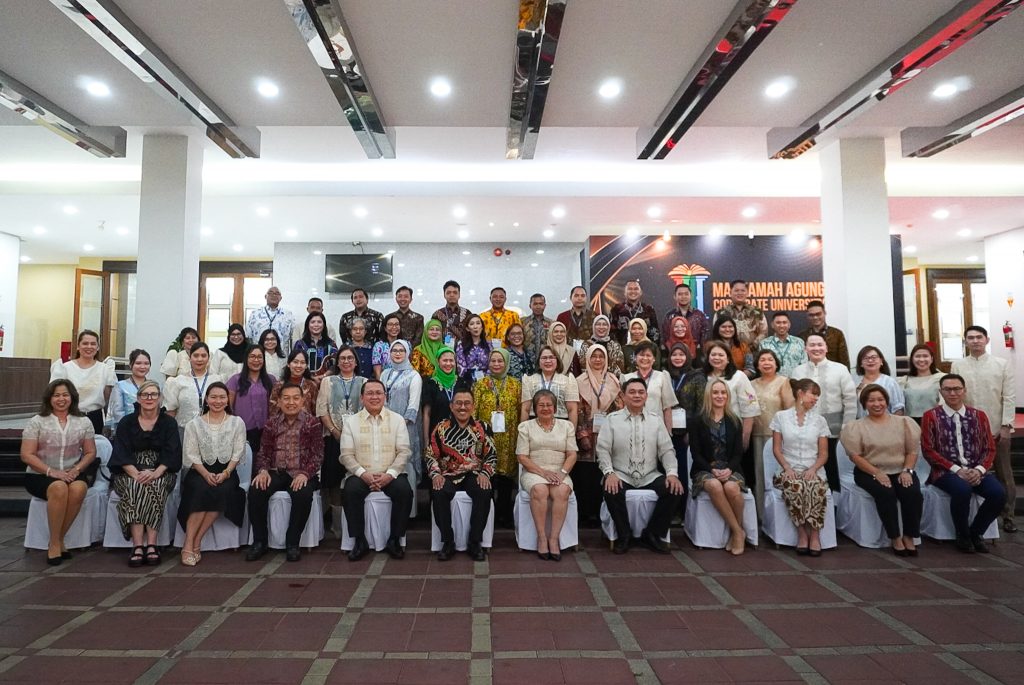
Supreme Court Associate Justice Japar B. Dimaampao (seated, fifth from left) and Philippine Judicial Academy (PhilJA) Chancellor and retired Supreme Court Associate Justice Rosmari D. Carandang (seated, sixth from right) pose for posterity with the delegation from the Philippines and from Indonesia, led by Justice Bambang Hery Mulyono, S.H., M.H., (seated, sixth from left) Head of the Research and Development Agency for Legal and Judicial Training of the Supreme Court Republic of Indonesia, on July 24, 2023 during the Welcome Dinner of the ASEAN Judicial Knowledge Exchange on Victim-Sensitive Adjudication of Trafficking in Persons (TIP) Cases in Indonesia. Also with Justice Dimaampao and Chancellor Carandang are Court of Appeals Associate Justice Jose Lorenzo R. dela Rosa (seated, fifth from right), Judicial Reform Program Administrator Atty. Laura C.H. Del Rosario (seated, second from right), other Court officials and Court lawyers, as well as select lower court judges. (Photo courtesy of the Office of Justice Japar B. Dimaampao)
Day 2
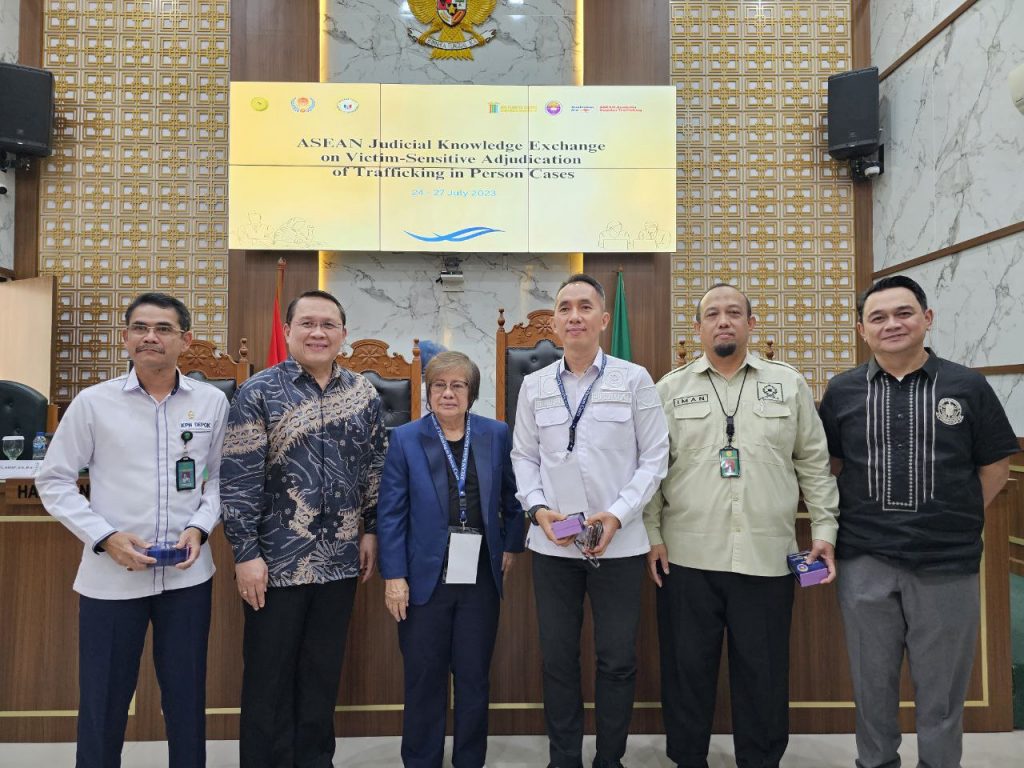
Supreme Court Associate Justice Japar B. Dimaampao (second from left), Philippine Judicial Academy (PhilJA) Chancellor and retired Supreme Court Associate Justice Rosmari D. Carandang (third from left), and Court of Appeals Associate Justice Jose Lorenzo R. Dela Rosa (rightmost) led the Philippine delegation during a visit to Pengadilan Negeri Depok, a District Court of Depok State on July 26, 2023, Day 2 of the ASEAN Judicial Knowledge Exchange on Victim-Sensitive Adjudication of Trafficking in Persons (TIP) Cases in Indonesia. Joining them are Dr. Ridwan Mansyur, S.H., M.H., Supreme Court Registrar (leftmost), Justice Syamsul Arief, S.H., M.H. Head of the Judicial Technical Education and Training Center; (third from right); and Hon. Iman Luqmanul, Chief Justice of Bogor District (second from right). (Photo courtesy of the Office of Justice Japar B. Dimaampao)
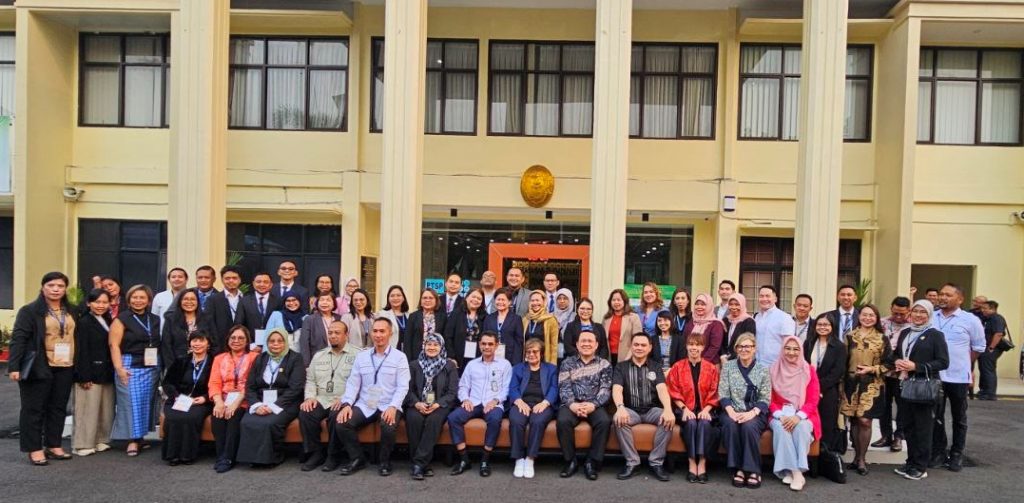
The delegates from the Philippines, led by Supreme Court Associate Justice Japar B. Dimaampao (seated, fifth from right) and Philippine Judicial Academy (PhilJA) Chancellor and retired Supreme Court Associate Justice Rosmari D. Carandang (seated, sixth from right), together with the delegates from Indonesia pose for posterity outside Pengadilan Negeri Depok, an Indonesian State Court, on July 26, 2023, Day 2 of the ASEAN Judicial Knowledge Exchange on Victim- Sensitive Adjudication of Trafficking in Persons (TIP) Cases in Depok, Indonesia, after a tour of the vicinity. Justice Syamsul Arief, S.H., M.H., Head of the Judicial Technical Education and Training Center (seated, fifth from left); Dr. Ridwan Mansyur, S.H., M.H., Supreme Court Registrar (seated, seventh from left); and Hon. Iman Luqmanul, Chief Justice of Bogor District (seated, fourth from left), gave an overview of their court practices, and in response, Regional Trial Court Judge Cynthia Martinez-Florendo (seated, second from left) shared the court practices and challenges in handling TIP cases in the Philippines. (Photo courtesy of the Office of Justice Japar B. Dimaampao)
Day 3
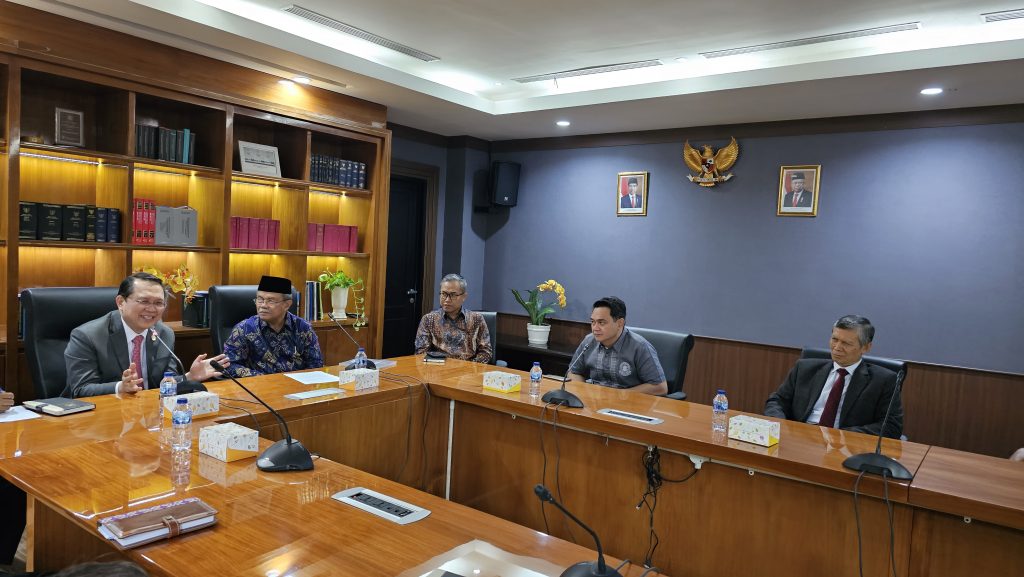
Supreme Court Associate Justice Japar B. Dimaampao (leftmost) joins Dr. H. Amran Suadi, SH., MH., MM, President of the Religious Chamber (second from left) and other Indonesian Justices and Judges for a dialogue on July 27, 2023 at the Supreme Court of Indonesia in the City of Jakarta for Day 3 of the ASEAN Judicial Knowledge Exchange on Victim-Sensitive Adjudication of Trafficking in Persons (TIP) Cases in Indonesia. Court of Appeals Associate Justice Jose Lorenzo R. Dela Rosa (second from right) also joined the Dialogue. (Photo courtesy of the Office of Justice Japar B. Dimaampao)
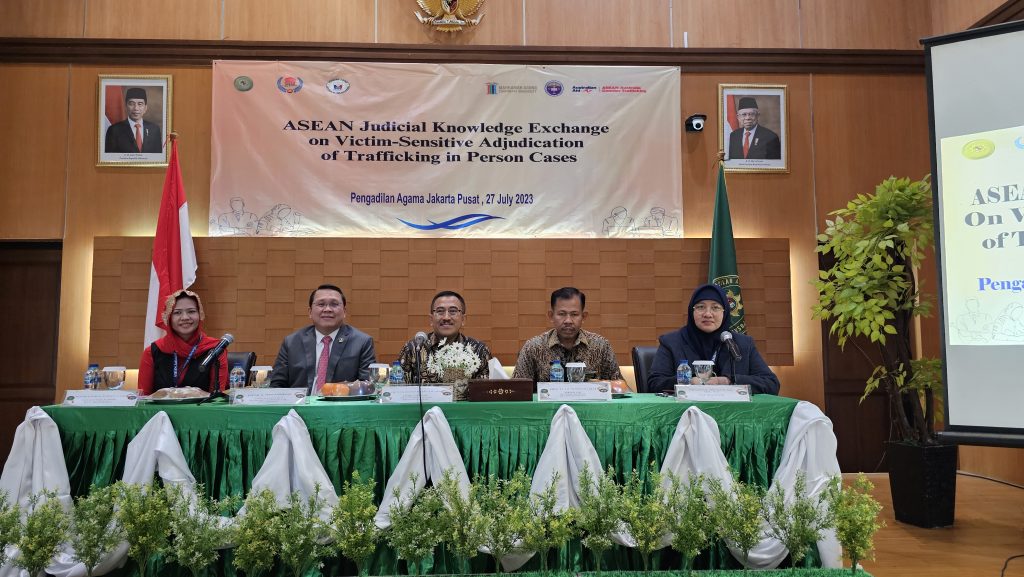
Supreme Court Associate Justice Japar B. Dimaampao (second from left) joins the panel which discussed religious court practices on July 28, 2023, Day 3 of the ASEAN Judicial Knowledge Exchange on Victim-Sensitive Adjudication of Trafficking in Persons (TIP) Cases in the Supreme Court of Indonesia, Jakarta, Indonesia. On the part of the Philippines, Judge Sittie Laarni Rakiin Umpa, RTC, Branch 9, Marawi City, Lanao del Sur (rightmost) shared the Philippines’ practices and challenges in religious courts. For Indonesia’s part, an overview of religious court practices in Religious Court of Central Jakarta was delivered by Judge Drs. H. Gunawan, M.H., Head of Central Jakarta Religious Court (second from right). Joining them are Justice Bambang Hery Mulyono, S.H., M.H., Head of the Research and Development Agency for Legal and Judicial Training of the Supreme Court Republic of Indonesia (center) and the moderator, Judge Frensita K. Twinsani, S.H., M.Si., M.H., Judicial Judge at the Research and Development and Education and Training Agency for Law and Justice of the Supreme Court of Indonesia (rightmost). (Photo courtesy of the Office of Justice Japar B. Dimaampao)
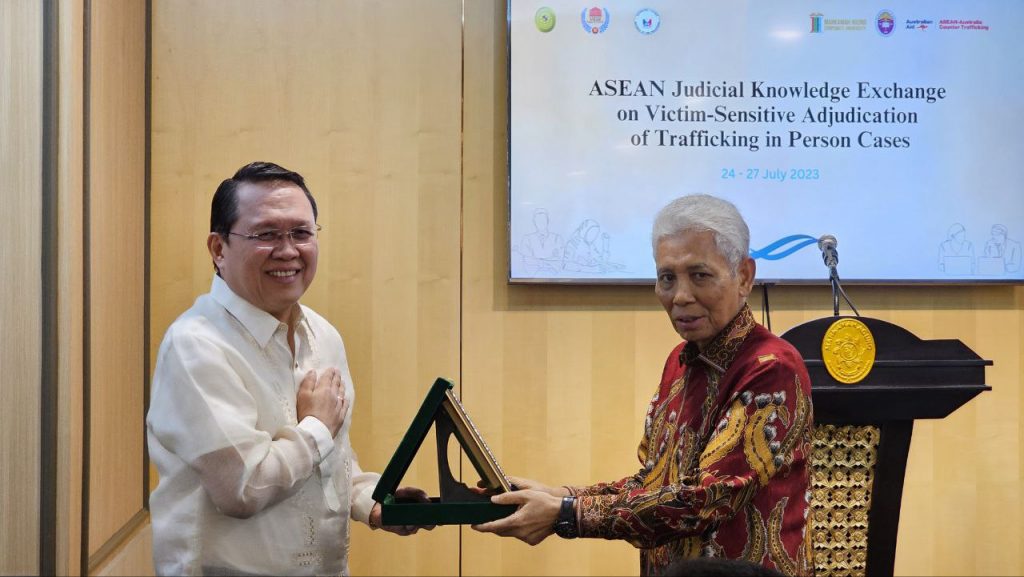
Supreme Court Associate Justice Japar B. Dimaampao receives a token from Prof. Dr. Takdir Rahmadi, SH LLM, Head of the Advisory Chamber of the Supreme Court of Indonesia during the Closing Dinner of the ASEAN Judicial Knowledge Exchange on Victim-Sensitive Adjudication of Trafficking in Persons (TIP) Cases in Jakarta, Indonesia. (Photo courtesy of the Office of Justice Japar B. Dimaampao)












